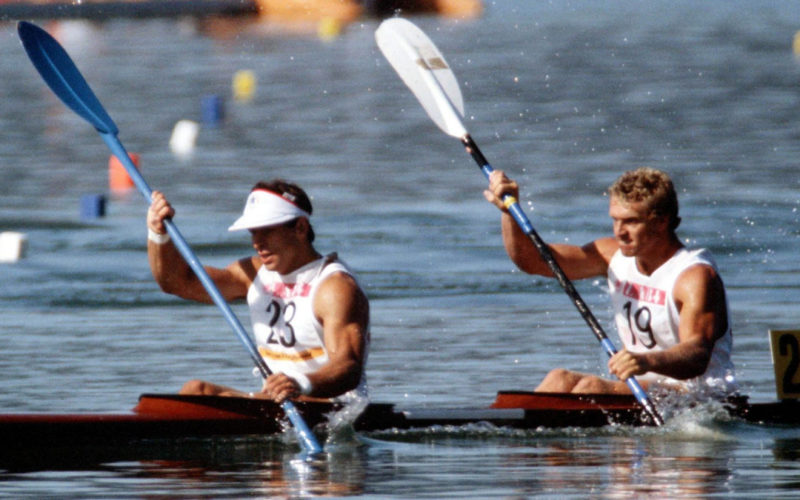By: Liam Birch
While Canoe Kayak Canada (formerly the Canadian Canoe Association) can boast 119 years of excellence and dedication to the sport of sprint canoeing in Canada, not all aspects of the Association’s history can claim the same duration. Here is a deeper look into when certain traditions and items were introduced to the National Championships regatta.
THE CHAMPION
The very first championships in 1900, hosted by the Bohemian Amateur Aquatic Association on the St. Lawrence River in Brockville, Ontario, only ever intended to determine the best competitor in each event, not the best club in the country. As such, only five events were run, including Canadian Singles, Tandem and Fours, the Half Mile War Canoe and the Double-Blade Singles. Over the next few years, other events were added (Intermediate Singles, Tandem and Fours, Junior Singles, Tandem and Fours and the Open Mile War Canoe in 1902) while others were dropped (Double-Blade events).
By 1904, it was decided to award title honours to the overall champion club based on a points system of first place=3, second place=2, third place=1. This points system would remain in place until 1928. Using this points system, applied to official races (as opposed to unofficial races such as the upset canoe race, etc.), the OTTAWA CANOE CLUB was the first Canadian Champion club of the Canadian Canoe Association.
THE ‘BEAUTIFUL’ TROPHY
As for the prize, that remains a bit of a mystery. The first reference I have found to a Championship prize is in 1914 (Toronto World, August 3) where a “handsome trophy” was presented to the winning club. In 1915, the Toronto Globe (August 9) claims that this is the “first time since 1906 that this trophy has gone to any club but the Red Ring boys of the T.C.C.” This makes sense (although it should read 1907), since Toronto had won the Championship for an unprecedented seven consecutive years from 1908-1914 and it was now heading to Balmy Beach. It also implies that the same trophy is collected from the previous year’s champion and awarded to the new champion, as opposed to a new trophy being purchased each year.
THE GRAND AGGREGATE PRIZE
Going into World War I, Balmy Beach would theoretically be in possession of this beautiful trophy, if it is indeed a perpetual annual prize. After World War I, Beach again won the championship and so the same trophy may have been won again. However, 1920 brings up all sorts of questions. The first tie for the championship occurred in Carleton Place, August 7, 1920. Balmy Beach and Ottawa-New Edinburgh finished the regatta with 12 points apiece. The Association, having not prepared for this outcome, resorted to a “coin toss” to determine who would walk away with the prize: Ottawa-New Edinburgh won the toss. What is interesting is that this trophy is still on display at the Ottawa New Edinburgh Club today, meaning it was never returned after having been won. To win a trophy outright usually meant winning it three times in those days (such as the Henry Birks Trophy for the Senior Men’s Half Mile War Canoe); the Burghs only ever won the championship twice. It is also notable that this cup is actually quite small, and engraved only with Ottawa-New Edinburgh’s 1920 win. It seems that this is a single trophy presented only in this year, which, conversely, implies that perhaps trophies were purchased yearly to present to championship clubs. Or, perhaps this practice was adopted after the war.

EVIDENCE LOST
If there were indeed separate prizes awarded from 1919 onwards, then that would leave the following clubs potentially in possession of a Grand Aggregate prize: Balmy Beach (1919), Ottawa-New Edinburgh (1920), Parkdale (1921), Humber Bay (1922, 1924), Rideau (1923, 1925) and Toronto (1926).
Balmy Beach suffered fires in both 1936 and 1963 and, to paraphrase historian Ken Bingham, “It’s all gone.” Parkdale suffered a fire in 1923 which could easily have wiped out a 1921 trophy. Toronto suffered a fire in 1957 in which, according to The Red Ringers: Toronto Canoe Club 1880-1980, “irreplaceable trophies dating back to the early days were destroyed and total damage was estimated at $100 000.” Humber Bay folded out of existence in 1925, never to be heard from again (they did not have an official boathouse). Rideau, having suffered the collapse of their boathouse in the winter of 1942, was able to salvage trophies from the canal, but there has been no evidence in their current collection of a Championship trophy from either 1923 or 1925.
THE BURGEE
The 10-foot ceremonial pennant awarded to the Championship-winning club that we have come to know today, first made its appearance in 1927. According to minutes from the 1927 Annual General Meeting (May 14th): “Moved… that the CCA purchase a Burgee, representing the Championship of the Annual Meet, and have it ready for presentation, and that the Clubs who purchased Burgees during the past two years be reimbursed.”
This is very interesting. It seems apparent that the two previous winners (Rideau 1925 and Toronto 1926) purchased their own championship pennants out of pocket. It is not guaranteed that Rideau was the first to do so, only that the CCA was prepared to reimburse the previous two winners. Mike Scott also references this in his book Rideau Canoe Club: A Century of Paddling where he states that “In 1924 (sic), 1925 and 1927, Rideau won the Canadian Canoe Championship burgee.” Regardless, Rideau itself is the first club to be physically awarded the burgee by the Association upon winning the championship meet in 1927. Unfortunately, there appears to be no evidence of these burgees in the club’s possession and could possibly have been lost or damaged beyond repair in the canal collapse of 1942.
The earliest evidence of these championship burgees today is from Gananoque. The Gananoque Motorboat and Canoe Club won the Championship for three consecutive years, 1933-1935. Two of those burgees (1934 and 1935) are still in the club’s possession although suffering from damage and decay to the canvas fabric.

Grand Trunk’s burgee from 1928 is probably long lost after the club folded in the 1960s and the Lachine pennants from 1929-1932 may still be in the club’s possession.
CONCLUSION
The burgee is certainly a coveted prize today. It always has been. Unfortunately, the physical item hasn’t always been preserved or given the showcase it deserves. Many still sit in boxes, gathering dust, while others hang prominently from club walls and rafters.
There are even mystery burgees such as the relatively new, undated burgee in Rideau’s possession (possibly a replacement or temporary burgee) or the mis-sewn 2005 burgee, presented to the winners of the 20 005 National Champions(!).


What exactly is the fate of these precious prizes? Only time will tell…



